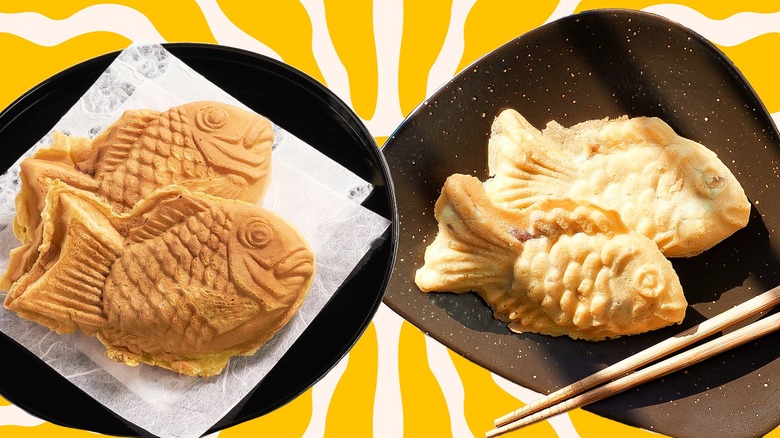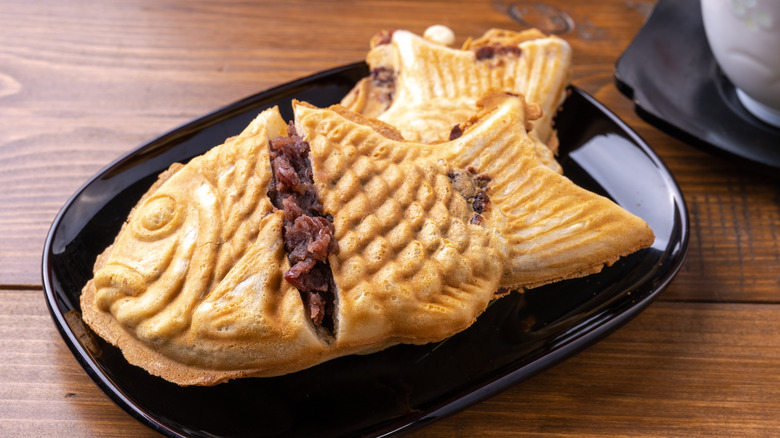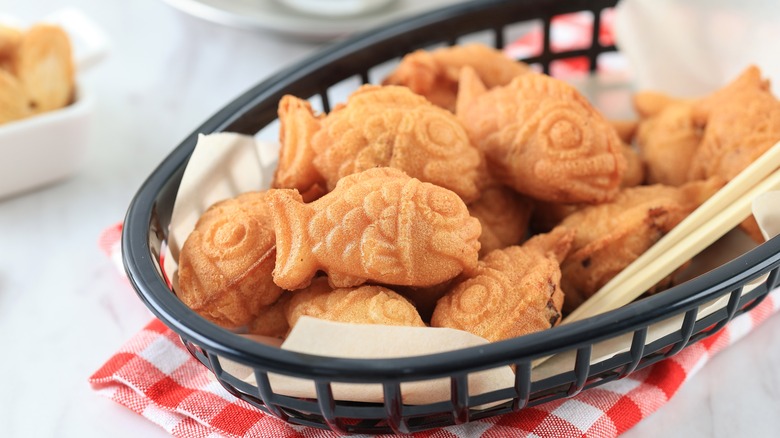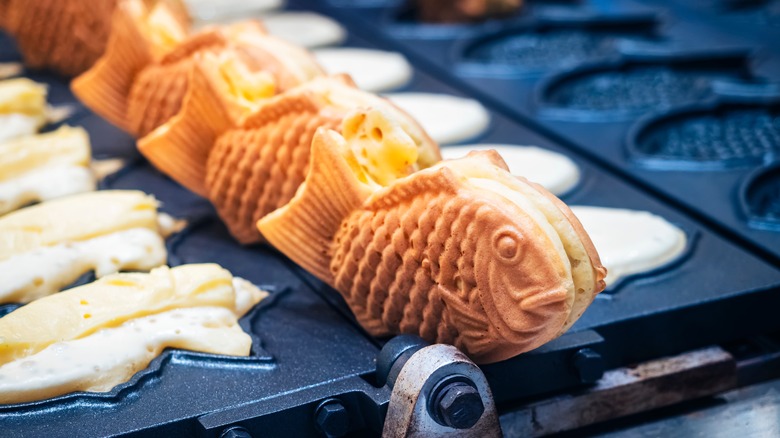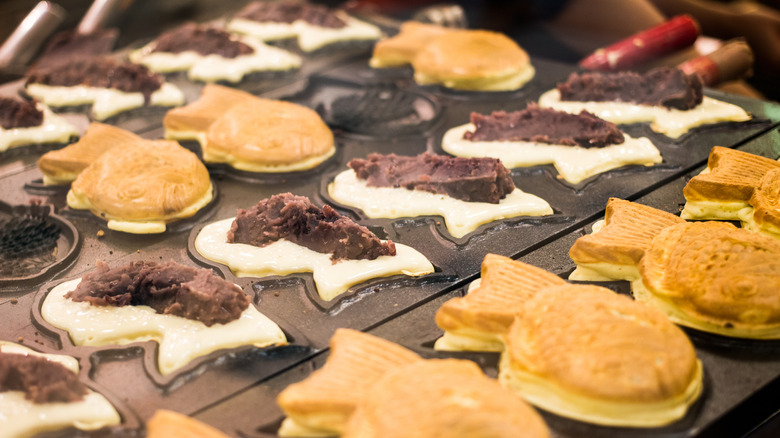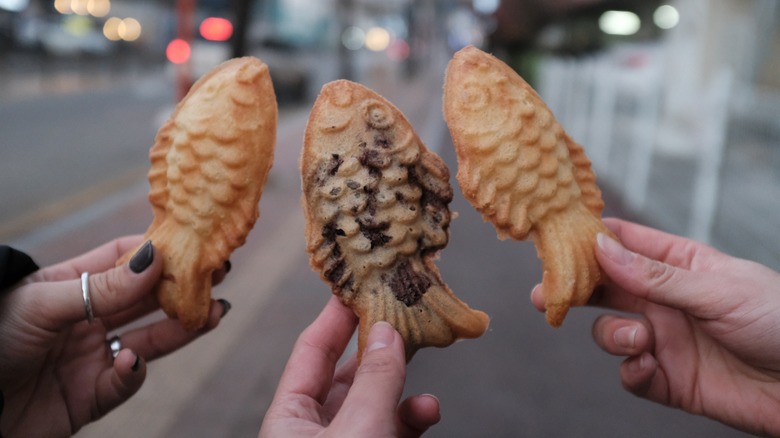Taiyaki Vs Bungeoppang: The Difference Between These Fish-Shaped Treats
Interest in Asian sweets has been on the rise. Maybe it is just a result of curiosity and the idea of trying something new. Perhaps it can be attributed to the unique and not overly sweet flavors that are not commonly found in the West. It could also be the adorable shapes and unique decorations used in Asian desserts.
One particular type of sweet street snack is gaining popularity outside of Asia: fish-shaped bread with flavored filling. These snacks are crispy and golden on the outside with fluffy bread on the inside and a sweet filling. Most people think all fish bread snacks are the same but there are actually two main types: taiyaki and bungeoppang.
Both desserts share the same basic concept of fish-shaped filled bread but there is more to these sweet treats than meets the eye. Despite their differences, both snacks are equally cute and tasty, as well as loved by hungry snackers of all ages and from around the world. From their country of origin to the different fillings that customers can choose from, here is everything that makes these two snacks unique.
What is taiyaki?
Taiyaki is a Japanese dessert commonly found at festivals and street food stands. There are also some shops and cafes that specialize in making taiyaki. The name directly translates to "baked sea bream". However, the name is also deceptive as the snack contains no actual fish in it. Instead, the name refers to the shape of the bread, which is specifically meant to be a sea bream. The bread is not only shaped in the silhouette of a fish but also features scales, fins, and details on the tail and face.
As for its texture, taiyaki's bread feels crisp on the outside and chewy on the inside. The batter is often compared to that of a waffle. For fillings, the most classic option is red bean paste, which is mildly sweet. Shops have expanded to include other flavors like chocolate, matcha, black sesame, and more. Taiyaki has also evolved quite a bit over time, with some shops using the fish molds to make taiyaki that holds ice cream.
What is bungeoppang?
Bungeoppang is a Korean seasonal street food that is popular during the winter. This dessert is known for being affordable while also warming customers up during cold days with the help of toasty batter and hot filling. These fish breads are made using shaped molds, which give the bread its silhouette as well as its eyes, scales, and fins; it functions in a way similar to how a waffle iron gives a waffle its ridges. Its name translates to "crucian carp bread", which is also part of what makes the shape of bungeoppang unique.
The texture and taste of bungeoppang are roughly the same as that of taiyaki. This is because bungeoppang is a variation of taiyaki, which was first introduced in Korea during the Japanese occupation of the country. When Japan had colonial control over the country, they brought taiyaki with them and Koreans began to develop their own version of the snack. The filling of choice for bungeoppang is still red bean paste. Manufacturers have also started making ice cream cones in the shape of bungeoppang, although these are primarily seen in dessert cafes rather than street food stands.
They have different shapes and sizes
One of the biggest differences between taiyaki and bungeoppang is their respective shapes. These snacks are named after different fish, and as such, the bread is shaped to model the fish they are named after. For example, the shape and direction of the fins tend to differ between the two snacks. Even the reason behind naming the two snacks is different; taiyaki was named after sea bream due to how prized and expensive the fish can be while bungeoppang is named after how commonly recognizable the crucian carp is.
Both snacks achieve their unique shapes with the help of a mold. Of course, molds for taiyaki and molds for bungeoppang have their own differences. Even though they function the same way, the molds for taiyaki come in various sizes while the molds for bungeoppang tend to come in one standard size. Additionally, taiyaki molds are more detailed than bungeoppang molds.
Taiyaki and bungeoppang have different fillings and flavors
Both snacks started with red bean paste as a filling but over time, these snacks have gone down very different flavor paths. Taiyaki had a larger expansion, encompassing more flavors than bungeoppang. Some flavors are seasonal, like chestnut paste filling during autumn. Additionally, taiyaki has started to appear in different batter colors, like pink for cherry blossom season or dark brown when chocolate is mixed into the batter. There are also variations in the batter used, as seen in croissant taiyaki and white mochi taiyaki, but the original version still remains the most popular.
Bungeoppang has been somewhat slower to expand. Although fillings like chocolate and ice cream have become more popular, bungeoppang turned down a more savory route with flavors like cheese, kimchi, and soybean paste. Bungeoppang has a few variations in batter too, like golden or black rice carp bread. In comparison to taiyaki, the batter for bungeoppang is less sweet and slightly crispier.
Different superstitions behind the snacks
There is a saying in both cultures that the way someone eats their fish-shaped snack will tell you a lot about that person. In both cases, superstitions are based on where a person starts eating the snack and is typically divided between the head, the tail, the stomach, and the top fin. There is also discussion about superstitions for people who cut their fish-shaped treat in half with a knife, but these are not as popular as the previously mentioned ones.
With taiyaki, it is said that those who start eating at the head are passionate and optimistic while those who eat from the tail are cautious yet romantic. It is said that people who eat taiyaki from the top fin are secretly very lonely. Last but not least, people who eat from the stomach are said to be nice but clumsy.
With bungeoppang, someone who eats from the head first is more likely to be a strong leader while someone who eats from the tail first is more reserved and shy. People who eat from the top of fish are supposedly fond of being by themselves and reflecting on who they are. Last but not least, people who eat from the stomach first are perceived to be quite sociable.
